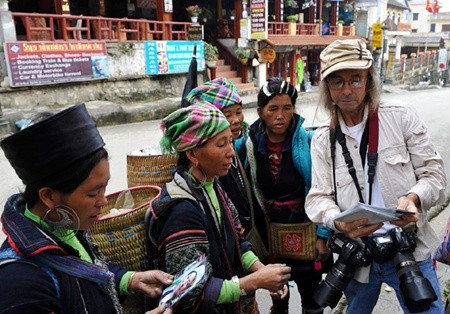(VOVworld) – Vietnam’s northwestern region has significant potential for tourism with historical sites, distinctive ethnic minority cultures, and unspoiled nature. The best way to tap the potential of each province and locality, turning nature, and culture into lures for tourists, is by increasing tourism links.

A foreign tourist chats with local ethnic women in Sa Pa Town – a popular tourist destination in the northwestern region. (Photo: Thanh Ha-VNA)
|
In recent years, tourists from European countries have become interested in tourism that involves exploring the undeveloped areas of Vietnam’s northwest. This is a boon for the region, which comprises Lao Cai, Yen Bai, Son La, Hoa Binh, Phu Tho, Ha Giang, Lai Chau, and Dien Bien province.
These provinces are attempting to create various co-operative models to attract more tourists, such as Lao Cai, Yen Bai, and Phu Tho’s "Returning to Origin". Eight northwestern provinces want to set up a tourism route that passes through poor villages to help improve local people's lives through tourism. Tran Huu Son, director of the Lao Cai Culture, Sports, and Tourism Department, said: “The strength of the 8 northwestern provinces is their beautiful natural landscapes, which are very attractive to foreign tourists, and their great potential for ecotourism. Many visitors are impressed by the beauty of the unspoiled forests, the mountain streams and rivers, and the bio-diversity. The region is famous for festivals, national parks, Dong Van Stone Plateau, terraced fields, and trekking routes. Travelers love to hike along the Nam La River from Muong Lay in Dien Bien to Son La or Lai Chau to Hoa Binh province.”
Each province is trying to design tourist products around local features. For instance, Lao Cai has invested in developing leisure tourism in Sapa town. Ha Giang uses Dong Van Stone Plateau as the centerpiece of its adventure tourism, while Yen Bai plays up its terraced fields at Mu Cang Chai and Thac Ba Lake, and Dien Bien focuses on the historic Dien Bien Phu battle site. Lai Chau is developing community-based tourism and Phu Tho is developing spiritual and religious tourism around the Temple of the Hung Kings. Pham Xuan Coi, Vice Chairman of the Dien Bien People’s Committee, stated: “The Dien Bien Phu historical complex has been a big contributor to the province’s socio-economic growth. We also have ecotourism and cultural tourism based on the traditions of local ethnic minority groups. The region is the place of origin of Thai ethnicity not only for Dien Bien but for all of Southeast Asia. We are proud of our specialties, like Dien Bien rice.”
In addition to enhancing inter-regional tourism, the northwestern provinces also want to link its tourism routes to the rest of the country. Vu The Binh, President of the Vietnam Tourism Association, said: “Cooperation among travel agents and tourism companies inside and outside the region is the key because outside provinces play a significant role in bringing more visitors to the northwest. Both sides should boost cooperation in creating tours for each other, providing more information, tourist products, and making the most of experience, knowledge, and financial resources to attract more tourists.”
By 2015, local authorities expect to receive 1.5 million foreign and 9 million domestic tourists per year and make 520 million USD from tourism. By 2020, the region hopes to welcome 2.3 million foreign tourists. To achieve those goals, the provinces are removing mechanism and policy barriers to encourage investors to invest in the region to create breakthroughs in tourism development and linking.